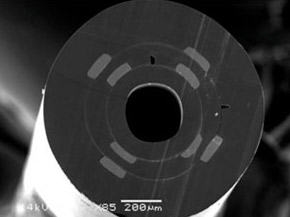Lensless cameras weave images from fibre
MIT creates glassless cameras out of optoelectronic material

MIT researchers have developed light-detecting fibres that, when woven into a web, act as a flexible camera.
The new fibres, less than a millimetre in diameter, are composed of layers of light-detecting materials nested instead one another.
Possible applications include a soldier's uniform made of a special fabric that allows him to see in all directions. Or pants that could automatically report when they're dirty.
Eyes in the back of your shirt
Unlike natural or man-made lenses, which have a limited field of view and are susceptible to damage, optical fibre webs can capture images across the entire surface of a fabric. If one area is damaged, other fibres can still function to extract the image.
Each layer in the fibre include two rings of light-sensitive semiconductor only 100 billionths of a metre across, each with four tiny metal electrodes. The whole array is encased in a polymer insulator to separate it from neighbouring material.
Individual fibres measure light intensity and wavelength (colour), then convert it to an electrical signal. Signals from the mesh of fibres can then be analysed by an algorithm to produce a photographic image.
Get the best Black Friday deals direct to your inbox, plus news, reviews, and more.
Sign up to be the first to know about unmissable Black Friday deals on top tech, plus get all your favorite TechRadar content.
"This is the first time that anybody has demonstrated that fabric can collect images just like a camera but without a lens," said MIT Professor Yoel Fink.
After demonstrating that his prototype clothing-camera could capture a basic image of a smiley face, he added: ""While the current version of these fabrics can only image nearby objects, it can still can see much farther than most shirts can." Nice one, Yoel!
Most Popular

